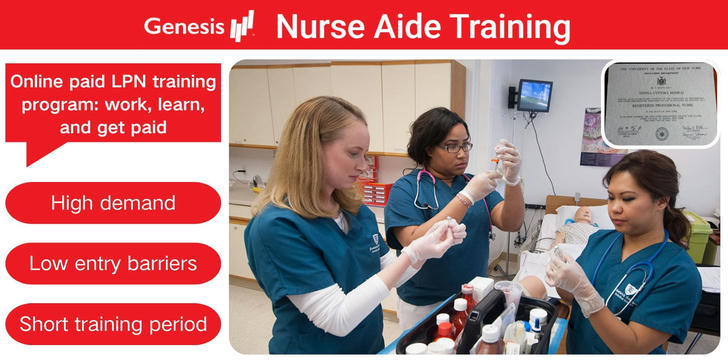How to Apply for a Paid LPN Training Program
The Licensed Practical Nurse (LPN) role offers one of the most accessible entry points into the healthcare industry. Today, many online programs not only provide flexible study options but also offer paid training, allowing participants to gain income and experience while studying—without putting their lives on hold.

Advantages of Choosing an Online LPN Program with Paid Training
Online LPN programs with paid training are designed for working adults, caregivers, and career changers who need flexibility and support throughout their educational journey. Here are the main advantages:
✅ Flexibility for Busy Schedules
Study at your own pace with 24/7 access to lectures, assignments, and online support.
Choose part-time or accelerated options to align with work or family responsibilities.
Evening and weekend study modules are available in most programs.
✅ Income Support During Training
Many programs collaborate with employers to provide paid clinical internships or stipends.
Healthcare facilities often sponsor tuition and offer compensation during hands-on training.
State and veteran programs may provide financial assistance, covering living expenses and educational costs.
✅ Technological and Academic Support
Students often receive a loaner laptop, online lab tools, and WiFi support.
Full access to tutors, academic advisors, mental health services, and career coaching.
Institutions such as Ultimate Medical Academy and Penn Foster offer dedicated student support services throughout the course.
✅ Localized Clinical Experience
Although coursework is online, clinical practice is arranged locally to avoid relocation.
Programs ensure placements in nearby hospitals, nursing homes, or healthcare centers, making it convenient for learners with family or job commitments.
Key Curriculum Content in LPN Programs
The typical LPN program spans 12 to 18 months, and includes both theoretical and practical training components. The curriculum covers:
Human Anatomy & Physiology: Understanding the structure and functions of the body.
Pharmacology: Safe medication administration and drug interactions.
Nursing Fundamentals: Basic patient care skills and clinical assessments.
Specialized Care: Training in pediatric, geriatric, and mental health nursing.
Infection Control & Safety Procedures: Critical protocols for clinical environments.
Medical Documentation: Accurate charting, reporting, and digital record-keeping.
Professional Ethics and Legal Standards: Ensuring compliance with healthcare laws and codes of conduct.
In addition to classroom learning, students complete supervised clinical hours in real healthcare settings, building confidence and competence before graduation.

Professional Benefits After Program Completion
Graduating from an accredited LPN program opens up numerous career opportunities and financial advantages:
📈 High Demand and Job Security
The U.S. Bureau of Labor Statistics projects a strong demand for LPNs through 2032.
LPN roles are considered recession-resistant, with consistent hiring in multiple care settings.
💰 Competitive Salary Potential
The average salary for an LPN is around $54,000 per year, with higher earnings in states like California, New York, and Massachusetts.
Additional bonuses and overtime options may increase total income.
🏥 Diverse Work Environments
Employment options include hospitals, long-term care facilities, home health agencies, rehabilitation centers, and schools.
Flexible shift options (day, night, weekend) support various lifestyle needs.
🚀 Pathway to Advanced Roles
Becoming an LPN is a stepping stone to roles like Registered Nurse (RN) or Nurse Practitioner (NP).
Many programs offer “bridge” options to transition into higher credentials with reduced time and cost.
Step-by-Step Guide to Enrolling
Step 1: Explore Accredited Online LPN Programs
Search for institutions that offer online LPN courses with employer partnerships or financial assistance. Examples include Ultimate Medical Academy, Penn Foster, and local community colleges.
Step 2: Review Entry Requirements
Most programs require a high school diploma or GED. Some may request a background check, immunization records, or a basic skills test.
Step 3: Apply for Sponsorship or Support
Look for opportunities through local hospitals or nursing homes that offer paid clinical roles or tuition reimbursement. Veterans may be eligible for GI Bill® funding.
Step 4: Submit the Application
Complete the application form online, and upload necessary documentation such as academic records and personal identification.
Step 5: Complete Entrance Assessments or Interviews
Some programs may schedule interviews or assessments to evaluate your fit and readiness.
Step 6: Confirm Clinical Placement
Ensure your chosen program provides assistance with local clinical assignments. Many have existing partnerships with facilities in multiple states.
Step 7: Attend Orientation and Begin Coursework
Once accepted, attend orientation sessions and get familiar with online tools, course schedules, and available support services.
Summary
An online LPN program with paid training offers a comprehensive and flexible route into the medical field. By combining remote academic study with local, compensated clinical practice, these programs make it possible to start a healthcare career without sacrificing income or personal obligations.
With high demand, competitive salaries, and opportunities for future advancement, LPN training is a strategic choice for those looking to enter or transition into healthcare. Consider institutions with strong support systems and employer partnerships to ensure both educational success and career readiness.
